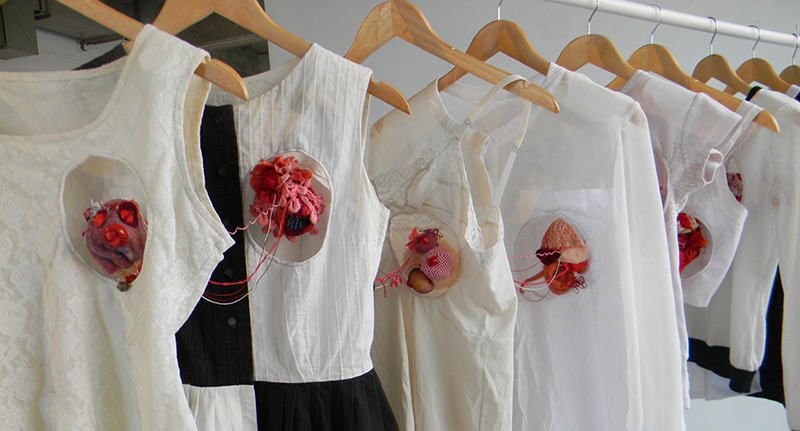VAV gallery’s student-run exhibit focuses on the things we wear

It’s an exhibit with a polyvalent outreach: fashion enthusiasts, art students and sustainability activists alike will be drawn to the latest display at Concordia’s VAV Gallery. Worn: An Exhibit of Wearable Art, debuted last week with the collaboration of the Fine Arts Student Alliance and under the careful guidance of curators Sara Amarica and Hanna van der Est. Works by 11 artists occupy the gallery’s space and pose new questions about the most versatile, prevalent and evocative art medium there is: clothing.
The carefully-worded mission statement describes how art is usually experienced as a relatively fleeting encounter between the viewer and the piece. However, “artworks that are intended to be worn, be it by the viewer or a performer, act directly on the body thereby intensifying the relationship between viewer and art object and acknowledging the physical presence of the body.” The assembly of artists and their varying works of wearable art speak to the body and its purpose as a “significant factor of identity.”
The curators asserted in the exhibit’s mission statement that all of the featured pieces are meant to be worn in a creative, artistically-minded way, despite the use of both conventional and more unusual materials—including twine, ceramic, cellophane and even what was initially thought to be cotton candy, but turned out to be fiberglass insulation.
A majority of the featured works are “hands-on” productions, as the textiles had been either manually crafted—in the case of knits—or manipulated to create unique and stand-out pieces of clothing. Worn underlines the fundamentals of (wearable) textile art and highlights sartorial self-expression.
At first it would be relatively easy to think that the artists collaborated together on one strong, unified collection, yet the gallery’s stark space was occupied by several independent pieces of work that come together cohesively under the proverbial umbrella of “what we wear.”
One installation featured two pressed “found” shirts that were hand-embroidered with simple, yet intricate designs. Another, a mixed media and textiles piece by Olivia Mansveld, showcased a clothing rack of minimal black and white shirts with holes cut out on the left side of the breast. Inside of these holes, linking every shirt together, were crocheted and felted heart-semblant organs. Though the message was not explicitly stated, the visual was striking.
Another similarly poignant piece was Stripped, a collaboration between five artists which examines clothing as a measure of capital and self-worth. “Clothing in any form is a signifier,” the statement reads. “[A]s children, we see past clothing, interacting with individuals as other humans instead of categories until we are taught the codes our society uses to typify wearables.” Using transparent and plastic clothing modelled by nude subjects, Stripped aims to define and reveal the person beneath the clothing, highlighting the flesh to shed pre-packaged ideas and the notion that a person is a pre-packaged object.
For all intents and purposes, not every piece featured in Worn is totally serious. The Bundle Up project, a yarn-bombing experience conceptualized by Montreal feminist university students was also featured.
“We thought it would be a great way to reach out to a lot of people within and without Montreal’s university scene and to have them interact with a feminist-activist art form,” said Stephanie Hornstein, one of the project’s founders. “The project was really about bringing a maximum of participants together and all working towards one goal,” she said.
With the collaboration of art collectives from Concordia, McGill, Université de Montréal and UQAM, Hornstein and her colleagues arranged knitting and crocheting workshops across campuses. The work produced was eventually draped over the statue of Louis Cyr in St. Henri, a playful and ironic contrast considering the strongman’s brawny and masculine exploits in life.
“As knitting is associated to the feminine/domestic realm and as such has traditionally been considered as a low-brow art form, releasing it into the public space is as pleasantly surprising as it is subversive,” reads the piece’s accompanying text box at VAV. The yarn bomb was installed in December and removed some days later.
Also worthy of note was the pop-up playtime corner that drew attention to felt replications of everyday objects, including both dog food and a clothesline of cartoonish fabric replications of sex toys.
All in all, the Worn exhibition speaks to the ephemeral nature of what we wear, as well as examines the implications of the sartorial choices that we often overlook or trivialize. This exhibit is an impressive amalgamation of some of Concordia’s promising artistic minds.
—
Worn is on display at Concordia’s VAV Gallery until April 17, located at 1395 Rene-Levesque Blvd.



